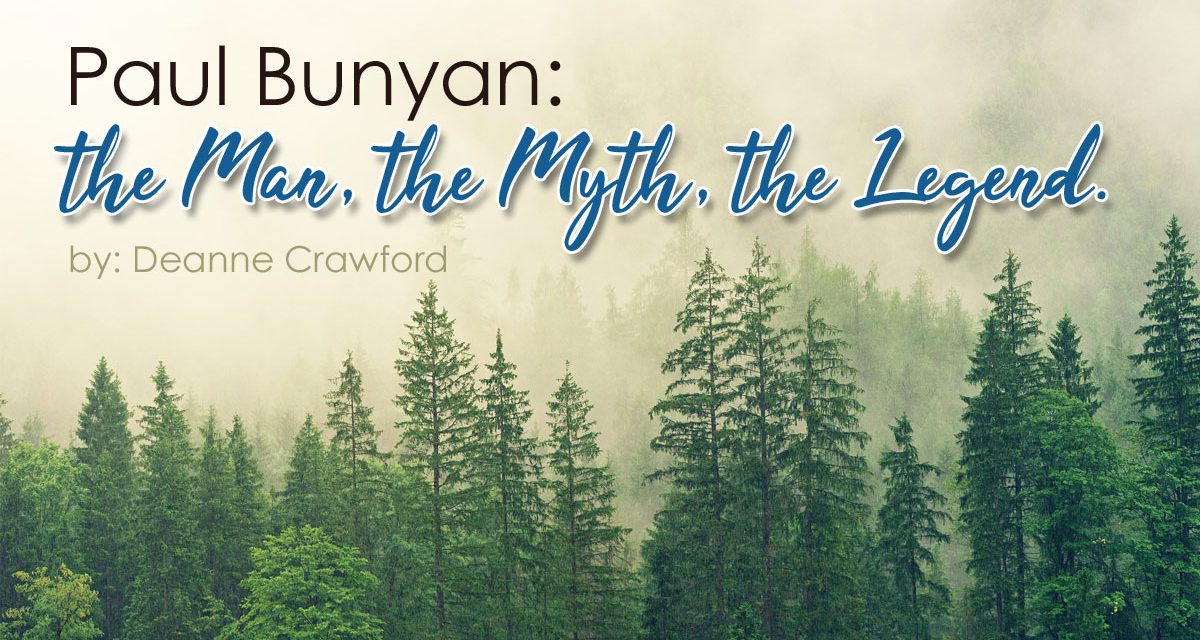He rode through the woods on a big blue ox,
He had fists as hard as choppin’ blocks,
Five hundred pounds and nine feet tall…that’s Paul. (Shel Silverstein)
The fascinating thing about tall tales is that the more they are told, the taller they become. What do we really know about the mysterious man known as Paul Bunyan? Was he a real person or a mythical character cooked up around the fire? Welcome to our June unit study dedicated to one of the tallest tales (and tallest characters) ever told! Engage your children in our study by introducing them to the 1958 Walt Disney classic cartoon Paul Bunyan on You-Tube®). Children will also enjoy the lively illustrations and story in the classic retelling by Steve Kellogg (or any retelling found on your bookshelf).
The story of Paul Bunyan and Babe the Blue Ox has been a beloved children’s classic for nearly a century. It has been suggested the oral narratives trace back to the mid 1800s. Over the years, various story details have been exaggerated, while others have faded into the background. For example, during the early retellings, Paul Bunyan stood just over 6 feet tall although today he towers well over 9 feet tall. Historians believe the legend was based on the real life persona of Fabian “Saginaw Joe” Fournier, a French Canadian lumber jack who traveled South to Michigan after the Civil War. Campfire retellings of the legendary adventures began to mingle with another Canadian and war hero, Bon Jean. It is theorized the French pronunciation of Bon Jean’s name evolved into the surname Bunyan. The earliest discovered writings about Paul Bunyan date back to the early 1900s. Originally printed in pamphlet format for a lumberjack homecoming celebration, the story took on a life of its own, as lumber companies borrowed elements to use in advertising.
An organic outflow of this unit study is language arts lessons. Children of all ages may enjoy creating their own tall-tales. Introduce to your children to the elements of a Tall Tale. Using this template, ask children to brainstorm, organize and write a Tall Tale. Language arts can be taken to the next level with your older children. Previously mentioned, anecdotal nuggets of Paul Bunyan’s tales found their way into promotional materials for the logging industry. In the early 1900s, story telling was vital for connecting products to consumers, but fell out of favor as lives grew busier and attention spans shortened. During the mid to late 1900s, stories became replaced by catchy slogans (think Nike®, “Just Do It!”) or melodious jingles. But alas, to paraphrase Solomon, “There is nothing new under the sun,” the resurgence of story-telling in the 21st century has been shown to be a vital connection to today’s consumers-like this 1984 Apple commercial. Invite your older children to craft a short story to “sell” their favorite product or service. Encourage them to create a short story to be told in 60 seconds or less. Practice and present for the family. Need a refresher? Short Story Elements provides a quick review.
Summer is a fabulous time to review geography with your children. Follow the travels of Paul Bunyan on a wall map and ask your children to locate the various locales integral to the Bunyan tale: Quebec, Canada; Bangor, Maine; Eau Claire Wisconsin, and Bemidji, Minnesota, just for starters. Learn (and map) 13 places where the larger-than-life Paul Bunyan has been spotted (in statue form at least!). Plan a trip (real or imaginary) to a few landmarks. Ask your children to map their route using an atlas. Older children can use a Distance Calculator to determine the distance between stops. Let’s add some math fun! Estimate the amount of fuel used for the trip by adding up the travel distance (include return trip). Determine the average miles per gallon for your vehicle. Divide the total length of your trip in miles by your car’s MPG. The result is how much gas you will need for the trip. For example, if you need to travel 300 miles and your car is rated at 20 MPG, you’ll need approximately 105 gallons of fuel. Calculate the total cost based on current gas prices. Verify your results using the Fuel Calculator at Fuel Economy.gov.
Generations have been entertained by the anecdotal tales of Paul Bunyan. His life and times represent much more than a quirky entertaining tale. Spun at a time when a harsh frontier life was the norm, his spirited tales encouraged a generation of men (and women). Ask your children to consider the positive character traits displayed by his life. Here are a few to get you started: diligent, adaptable, and self-motivated. This is also an excellent time to praise the positive character traits you notice in your children. I love to end precious learning time with my children on a positive note!
It is my prayer this study has been a blessing to your family. I would love to hear your unit study stories or ideas for future unit studies. You can email me at dcrawford@rainbowresource.com.
Blessings on your summer learning,
Deanne





